Veeam plug-in for backup and recovery of SAP HANA databases
This season, Veeam developers have introduced a solution for backup and recovery of SAP HANA servers and databases. Readers of our blog showed interest in the new product - and here a useful article from my colleague Clemens Zerbe just arrived. Today I will share it with you, adding a little. So welcome to cat.

As you can see from the picture, the complete solution for SAP HANA includes:
As mentioned above, the plugin uses the SAP Backint API to work directly with the SAP HANA database. HANA maintains its own backup directory with custom retention policies and creation intervals. So Veeam Backup & Replication only remains that take data from data pipes and put them in the repository.
During recovery, SAP HANA tells Veeam Backup & Replication which data to restore and Veeam pulls it out of the repository.
Data transfer operations are performed using the Veeam Transport Agent component, the transport agent, which should be kept in mind when planning your deployment.
If you draw a picture about the interaction of components, then it will look like this:

Note: It should be borne in mind that SAP HANA Backint only works with the database, performing various types of backups - full, differential, incremental - and logs. He (Backint) is also used for recovery. In addition, in addition to the actual data, there are also SAP HANA installation and configuration files, and all this runs on the Red Hat or SUSE operating system. This should not be forgotten either. So if you need a backup of the server itself or files, then for this you will need another toolkit.
Yes, the plugin itself is included in Veeam Backup & Replication 9.5 Update 4 (or 4a ) in the Enterprise Plus edition.
First, of course, we check compliance with system requirements. Supported OS:
SAP HANA 2.0 SPS 02 / SPS 03 / SPS 04 is supported. Express Edition is not supported.
To perform a test installation of the plugin, backup and restore the database, you will need:
Installation files are stored on Veeam Backup & Replication ISO in the / Plugins / SAP HANA / x64 directory.
Useful: Actually, the installation is quite cheerful, but just in case for fans of even higher speeds, who have Veeam Backup & Replication 9.5 Update 4a, there is such a specialized performance patch for HANA .
Important! To configure Veeam Plug-in, you will need a user account with DB admin rights on all SAP HANA instances of this server. SAP HANA High Level Isolation is not supported.
Note: If SAP Backint has already been preconfigured, you will receive a message which steps need to be done additionally and at what point to restart this wizard.
The easiest way is to use SAP HANA Studio for this, but you can also use any other tool, for example, SAP HANA Cockpit, DBA planer or some external sheduler.
Pay attention to a few points in the settings:
Finally, everything is checked, start the backup.
If you now open the Veeam Backup & Replication console, you will see the following there:
It worked! With what I congratulate you, and now we proceed to recovery.
Important! All test procedures, such as the one described below, should be performed only in the test infrastructure and next to your colleague - SAP Basis-admin. Never perform test and training procedures on production! (Your Captain Evidence :)
In this example, we will restore the tenant base to its current state (system databases, as a rule, require restoration only in case of some serious problems, and for such a restoration, you may need to consult SAP technical support).
The process has begun! When it finishes, you will see something like this dialog:

So, the backup and restore have completed. The Veeam Plug-in for SAP HANA played its imperceptible at first glance, but important role in these processes (by the way, it is certified by SAP). To be continued!

As you can see from the picture, the complete solution for SAP HANA includes:
- Veeam Backup & Replication - for backup SAP HANA servers at the image or file level, with support for recovery.
If your server is virtualized, then the best backups recommend Veeam Backup & Replication; for the physical server there is Veeam Agent for Linux. Both have fairly detailed documentation, plus articles on our blog here. - Veeam Plugin - for backup and recovery of SAP HANA databases in view of transactions.
This plugin can use SAP Backint (native API) to backup databases and transaction logs and save backups to the Veeam repository (including the scalable repository - SOBR). I’ll talk about this plugin today.
We consider the plugin closer
As mentioned above, the plugin uses the SAP Backint API to work directly with the SAP HANA database. HANA maintains its own backup directory with custom retention policies and creation intervals. So Veeam Backup & Replication only remains that take data from data pipes and put them in the repository.
During recovery, SAP HANA tells Veeam Backup & Replication which data to restore and Veeam pulls it out of the repository.
Data transfer operations are performed using the Veeam Transport Agent component, the transport agent, which should be kept in mind when planning your deployment.
If you draw a picture about the interaction of components, then it will look like this:

- When you start the database backup process, SAP HANA Backint immediately launches the Veeam Plug-in services.
- The Veeam Plug-in connects to the Veeam Backup & Replication server and creates a backup job object there , so that SAP HANA backups become visible to the Veeam backup admin.
- The Veeam Plug-in then runs the Veeam Transport Agents on the SAP HANA server and on the repository. Each of these agents creates a separate channel for backup data streams.
- Veeam Transport Agents transfer data to the repository.
Note: It should be borne in mind that SAP HANA Backint only works with the database, performing various types of backups - full, differential, incremental - and logs. He (Backint) is also used for recovery. In addition, in addition to the actual data, there are also SAP HANA installation and configuration files, and all this runs on the Red Hat or SUSE operating system. This should not be forgotten either. So if you need a backup of the server itself or files, then for this you will need another toolkit.
Yes, the plugin itself is included in Veeam Backup & Replication 9.5 Update 4 (or 4a ) in the Enterprise Plus edition.
Start installation
First, of course, we check compliance with system requirements. Supported OS:
- SUSE Linux Enterprise Server for SAP Applications 12 SP1 / SP2 / SP3 / SP4 (x86_64)
- SUSE Linux Enterprise Server for SAP Applications 15 (x86_64)
- Red Hat Enterprise Linux for SAP Applications 7.2 / 7.3 / 7.4 / 7.5 (x86_64)
SAP HANA 2.0 SPS 02 / SPS 03 / SPS 04 is supported. Express Edition is not supported.
To perform a test installation of the plugin, backup and restore the database, you will need:
- Configured Veeam backup repository (without encryption!) And the necessary access rights to it.
- For Veeam repository and for your HANA system, DNS resolution must be supported (for both forward and reverse).
- HANA system version 2.0 SPS02 or higher, running on x86.
- Support for a friend - if you are a Veeam admin, then it is advisable to have a colleague with experience working with SAP Basis, and vice versa.
Installation files are stored on Veeam Backup & Replication ISO in the / Plugins / SAP HANA / x64 directory.
- Mount ISO, go to the directory / Plugins / SAP HANA / x64 . Copy the desired file ( .rpm or tar.gz ) to the SAP HANA server.
- We launch the corresponding command on this server, for example:
sudo rpm -i VeeamPluginforSAPHANA-XXXXXXX.x86_64.rpm
Note: You can use Putty or any other ssh client to connect to the system. To install, you will need an account with sudo rights.
- We are waiting for the installation to complete and the invitation to launch the SapBackintConfigTool --wizard configuration wizard.
Useful: Actually, the installation is quite cheerful, but just in case for fans of even higher speeds, who have Veeam Backup & Replication 9.5 Update 4a, there is such a specialized performance patch for HANA .
Let's move on to setting up
Important! To configure Veeam Plug-in, you will need a user account with DB admin rights on all SAP HANA instances of this server. SAP HANA High Level Isolation is not supported.
- With root privileges, run SapBackintConfigTool --wizard .
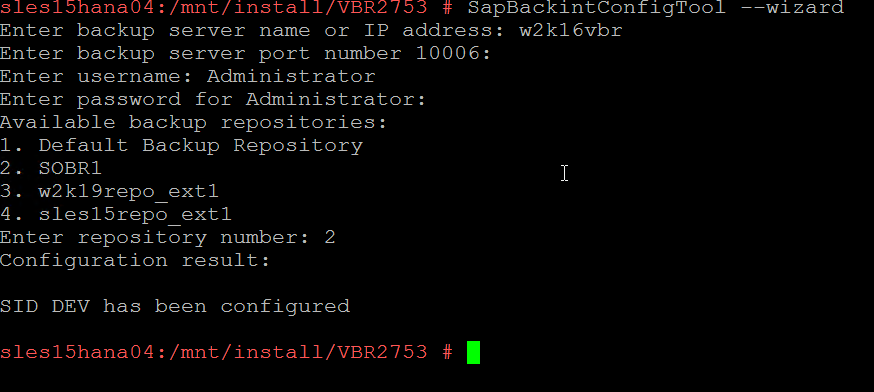
- Here we will need to indicate:
- Veeam backup server name or IP address
- Port for communication with this server - by default 10006
- Username and password for access to the same server - the account and access rights must be organized by the administrator responsible for Veeam Backup & Replication
- Repository where backups will be saved - if everything is in order with rights, a list of all available repositories will be displayed. They will be renumbered, you must enter the number you need. In this example, the repository at number 2 in the list (its name is SOBR1 ) was selected.
- The wizard does the rest automatically, namely, it saves the settings to the file /opt/veeam/VeeamPluginforSAPHANA/veeam_config.xml and activates SAP Backint via a soft link.
Note: If SAP Backint has already been preconfigured, you will receive a message which steps need to be done additionally and at what point to restart this wizard.
We make the first backup
The easiest way is to use SAP HANA Studio for this, but you can also use any other tool, for example, SAP HANA Cockpit, DBA planer or some external sheduler.
- Launch SAP HANA Studio and connect to the desired SAP HANA instance in Multiple containers → System database mode. (Here you have the right to count on the friendly help of the SAP Basis admin - he will indicate the host name and instance.)
- We select authentication using the user account - Authentication by database user . We enter the username and password for SAP HANA (in our example, this is system - but this is optional, you can create an account specifically for backup and restore operations with backup and catalog rights. This is written in the HANA documentation).

- If everything is fine with the settings, then after passing the wizard, you will see something like this in the console window:

If you click on the SYSTEMDB @ SID (SYSTEM) node, a window with detailed properties will open. - And we right-click on this node and select the Backup and Recovery → Open Backup Console menu item:

- Go to the Configuration tab and click on Backint settings there . If we see / opt / Veeam / VeeamPluginforSAPHANA / hdbbackint in the Backint Agent field, it means that all the settings are made as necessary.
Pay attention to a few points in the settings:
- Since Veeam does not use Backint Parameter files , the corresponding fields must be empty. If there is anything in them, clean them.
- Log backup settings make it possible to store logs on the file system ( File option) or use Backint to send logs to Veeam Backup & Replication. The second option ( Backint option) is preferable, but only after confirmation from your SAP Basis admin.
- If you changed any settings, do not forget to save them.
Finally, everything is checked, start the backup.
- Right-click on the node of our SYSTEMDB @ DEV database and select the Backup and Recovery → Back Up System Database command (and then there will also be Backup Tenant Database ).
- Choose the type of backup we plan to create. As the Destination type, select Backint , click Next .
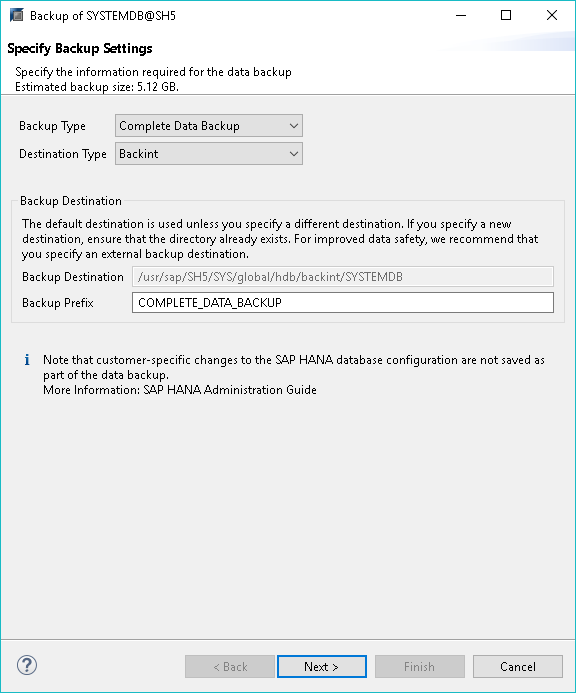
- Once again, we look through all the parameters and click Finish .
- We observe the progress of the process.
- When everything is over, check if the logs are in place - in the Backup Execution Summary, click on the Open Log File link.

- We return to the Backup System DB dialog and open the Backup Catalog backup directory. There should be a detailed description of the backup you just created, like this one:
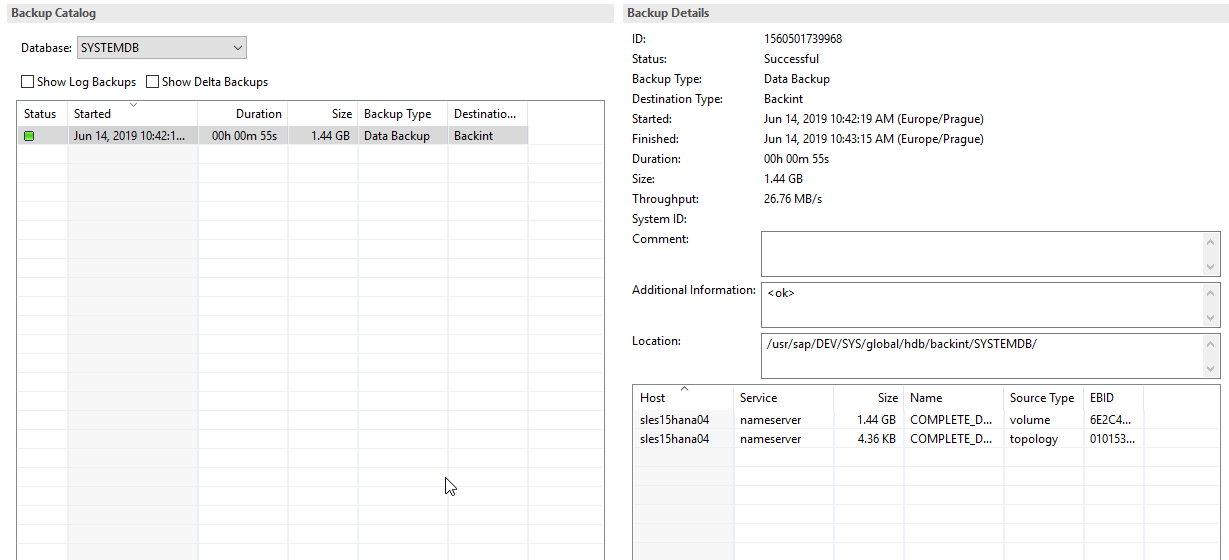
- We repeat the same procedure for tenant: start the backup of the database, check the logs, see what is in the directory.
If you now open the Veeam Backup & Replication console, you will see the following there:
- A new task has appeared under the Jobs node with a name of the kind “hostname SAP backint backup (repository name)"
- A new Plug-ins folder has appeared under the History node (for Sap HANA & Oracle RMAN).
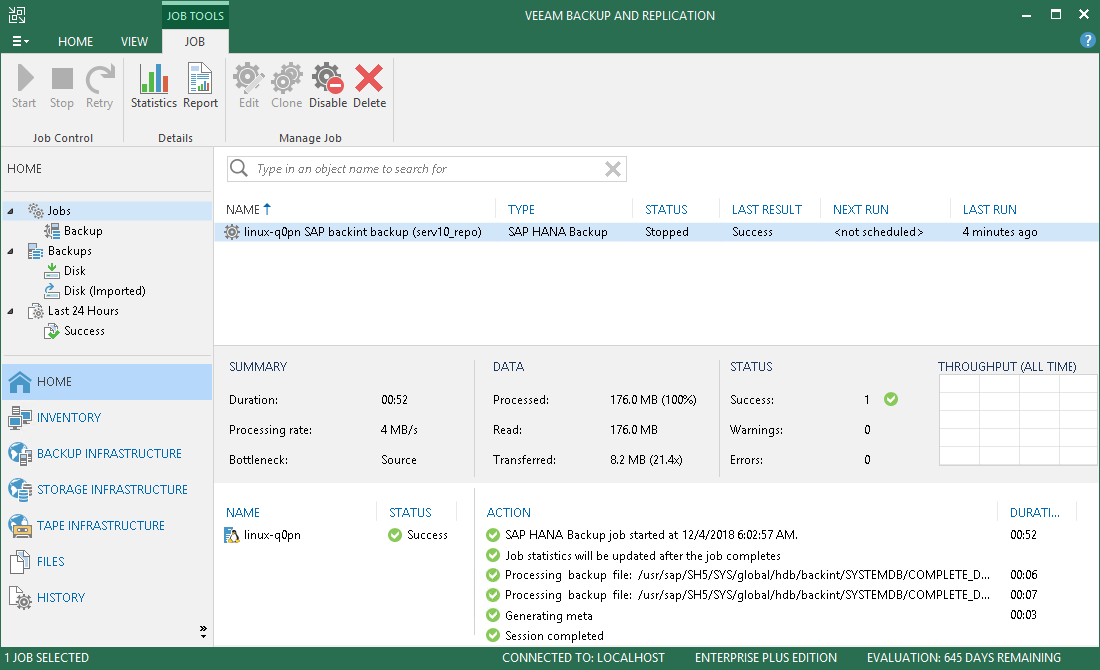
It worked! With what I congratulate you, and now we proceed to recovery.
Restore the base
Important! All test procedures, such as the one described below, should be performed only in the test infrastructure and next to your colleague - SAP Basis-admin. Never perform test and training procedures on production! (Your Captain Evidence :)
In this example, we will restore the tenant base to its current state (system databases, as a rule, require restoration only in case of some serious problems, and for such a restoration, you may need to consult SAP technical support).
- Click on our SYSTEMDB @ DEV node and select the Backup and Recovery - Recover Tenant Database menu command.

- Choose tenant, click Next .
- We select the option Recover the database to its most recent state (restore the database to the latest state). There is also an option and recovery for a selected point in time.
- If you backed up to Backint (that is, through Backint to the repository), select the option to search for backups in the corresponding directory: Search for the backup catalog in Backint only . If the file system - then Search for the backup catalog in the file system only .

Attention! When restoring for DB shutdown will be executed! - From the list of backups, select the one you need. If you need to make sure it is available, click Check Availability .
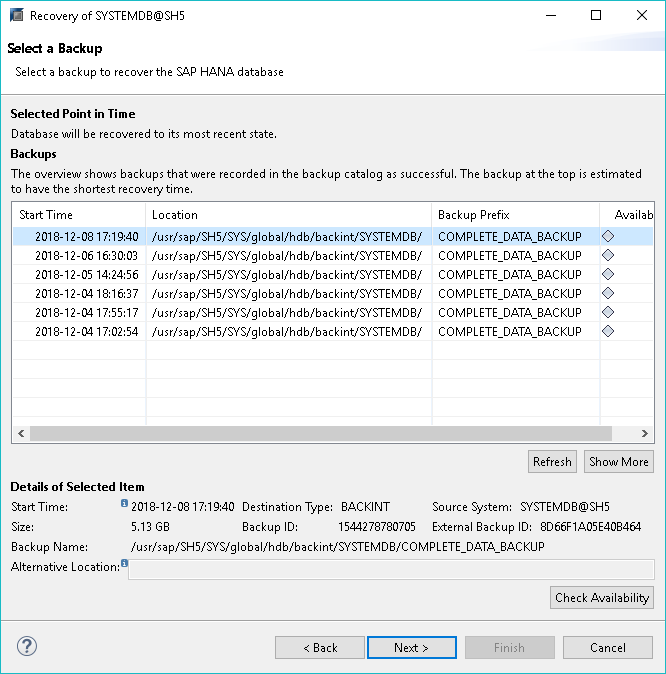
- Then (after the green availability check indicator lights up next to our backup), go to the Locate Log Backups step and click Next again.
- Next, at the Other Settings step, specify that you need to take the logs from the place where we saved them through Backint. (In general, all the settings at this step need to be verified with the SAP Basis admin.)
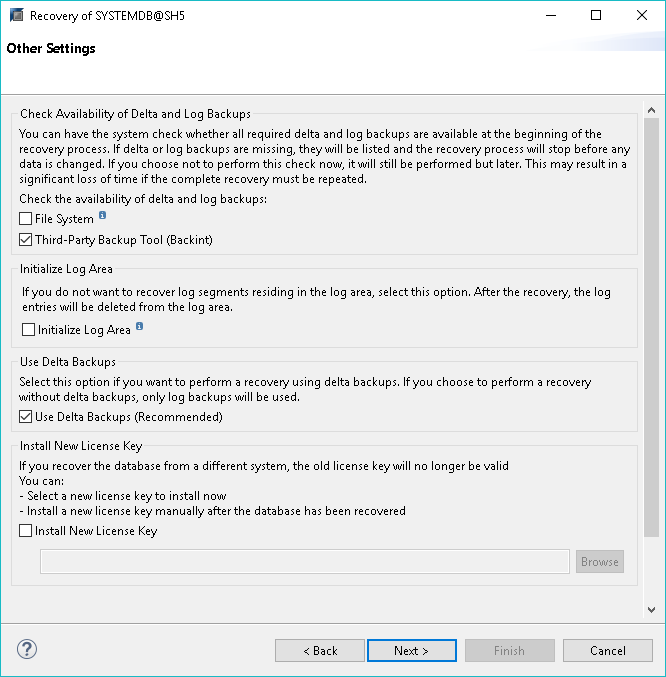
- Click Next , look again at the description of all the settings and click Finish .
The process has begun! When it finishes, you will see something like this dialog:

So, the backup and restore have completed. The Veeam Plug-in for SAP HANA played its imperceptible at first glance, but important role in these processes (by the way, it is certified by SAP). To be continued!
Sitelinks
All Articles